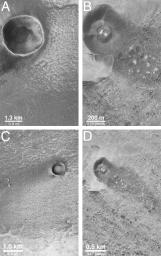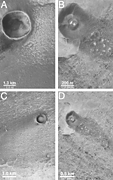
|
Wind Streaks of Daedalia, Mars, and Amboy, California
- Click the image above for a larger view
- Full-Res JPEG (720 x 1145) (201.8 kB)
- Full-Res TIFF (720 x 1145) (880.1 kB)
Caption:
|
These pictures compare an image of wind features on a lava field on Mars with similar features on a lava field in southern California. The first picture (above, left) shows that the martian example occurs in western Daedalia Planum, a region covered by long, dark-toned lava flows southwest of Arsia Mons, the southernmost of the three large Tharsis Montes. The second picture (above, center) is Mars Global Surveyor (MGS) Mars Orbiter Camera (MOC) image no. AB1-10905. It was acquired on January 29, 1998. What struck the MOC Science Team as most exciting about this image was that the relationship between lava flows, bright windblown sediment, and dark wind tails behind craters in AB1-10905 reminded them of a similar scene near Amboy, California, in the Mojave Desert (above, right).
Based upon observations of Daedalia Planum from the Viking orbiters in the late 1970s, it has been assumed for 20 years that most of Daedalia Planum is a lava flow field that is mantled by bright dust. However, the similarity to the Amboy lava field in California has caused some scientists to re-think the situation on Mars. Instead of bright dust, it now appears that bright sand might be present in this portion of Daedalia Planum.
What's the difference between dust and sand? Observations from the Viking and Mars Pathfinder landers have suggested that martian dust consists of very, very tiny particles of less than 10 micrometers (less than 1/10th the width of a human hair). Sand, on the other hand, is defined by sedimentologists as consisting of particles with sizes in the range 62.5 to 2000 micrometers(2000 micrometers is 2 millimeters, or about 8-hundredths of an inch). In the martian environment, sand moves close to the ground by bouncing and hopping when strong enough gusts of wind come along, this is called saltation. Dust, on the other hand, gets picked up by the wind and travels by being suspended in the air. When dust settles back to the ground, it forms a coating that blankets surfaces in a fairly uniform manner, whereas sand makes drifts, tails, and streaks as it interacts with obstacles such as craters, hills, and the lumpy surfaces of lava flows.
At the Amboy lava field in California, bright sand is being blown across the dark lava from adjacent dry streambeds. When this sand encounters a volcanic cinder cone that rises above the lava field (pictures "B" and "D" in the above, right figure), the sand is deflected around the cone and leaves a dark "shadow" in which very little bright sand gets deposited. A similar situation is seen with respect to craters formed by meteor impact in the Daedalia Planum image AB1-10905 (pictures "A" and "C" in the above, right figure). The spectacular Amboy wind streak, lava flows, and cinder cone can often be seen from an airplane by passengers flying into or out of Los Angeles International Airport (LAX) from points east such as Denver, Colorado.
MOC image AB1-10905 is illuminated from the left. The Amboy lava flows and cinder cone volcano are illuminated from the lower right. The Amboy photographs were taken from an airplane and are from the U.S. Geological Survey. Wind has blown material from right to left in the MOC image, and from upper left toward lower right in the Amboy pictures. North is up in all figures.
For a higher-resolution view of the AB1-10905 MOC image (2.4 MBytes), CLICK HERE .
Cataloging Keywords:
| Name | Value | Additional Values |
|---|---|---|
| Target | Mars | |
| System | ||
| Target Type | Planet | |
| Mission | Mars Global Surveyor (MGS) | Mars Pathfinder (MPF), Viking |
| Instrument Host | Mars Global Surveyor | |
| Host Type | Orbiter | |
| Instrument | Mars Orbiter Camera (MOC) | |
| Detector | ||
| Extra Keywords | Crater, Dust, Grayscale, Impact, Mountain, Shadow, Volcano | |
| Acquisition Date | ||
| Release Date | 2000-04-24 | |
| Date in Caption | 1998-01-29 | |
| Image Credit | NASA/JPL/MSSS | |
| Source | photojournal.jpl.nasa.gov/catalog/PIA02363 | |
| Identifier | PIA02363 | |



